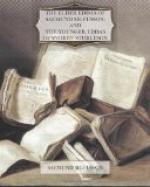“The wolf Fenrir was bred up among the gods; but Tyr alone had the daring to go and feed him. Nevertheless, when the gods perceived that he every day increased prodigiously in size, and that the oracles warned them that he would one day become fatal to them, they determined to make a very strong iron fetter for him, which they called Laeding. Taking this fetter to the wolf, they bade him try his strength on it. Fenrir, perceiving that the enterprise would not be very difficult for him, let them do what they pleased, and then, by great muscular exertion, burst the chain and set himself at liberty. The gods, having seen this, made another fetter, half as strong again as the former, which they called Dromi, and prevailed on the wolf to put it on, assuring him that, by breaking this, he would give an undeniable proof of his vigour.
“The wolf saw well enough that it would not be so easy to break this fetter, but finding at the same time that his strength had increased since he broke Laeding, and thinking that he could never become famous without running some risk, voluntarily submitted to be chained. When the gods told him that they had finished their task, Fenrir shook himself violently, stretched his limbs, rolled on the ground, and at last burst his chains, which flew in pieces all around him. He then freed himself from Dromi, which gave rise to the proverb, ’to get loose out of Laeding, or to dash out of Dromi,’ when anything is to be accomplished by strong efforts.
BINDING THE WOLF FENIR
“After this, the gods despaired of ever being able to bind the wolf; wherefore All-father sent Skirnir, the messenger of Frey, into the country of the Dark Elves (Svartalfaheim) to engage certain dwarfs to make the fetter called Gleipnir. It was fashioned out of six things; to wit, the noise made by the footfall of a cat; the beards of women; the roots of stones; the sinews of bears; the breath of fish; and the spittle of birds. Though thou mayest not have heard of these things before, thou mayest easily convince thyself that we have not been telling thee lies. Thou must have seen that women have no beards, that cats make no noise when they run, and that there are no roots under stones. Now I know what has been told thee to be equally true, although there may be some things thou art not able to furnish a proof of.”
“I believe what thou hast told me to be true,” replied Gangler, “for what thou hast adduced in corroboration of thy statement is conceivable. But how was the fetter smithied?”




